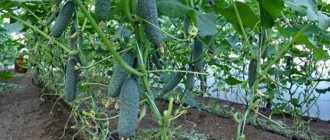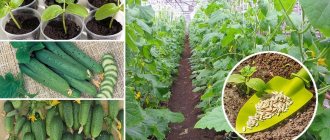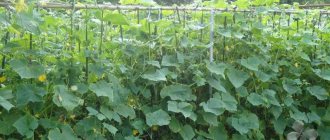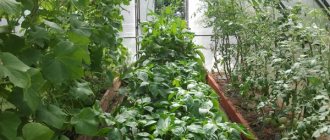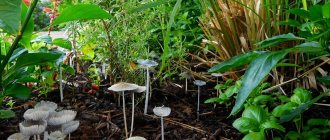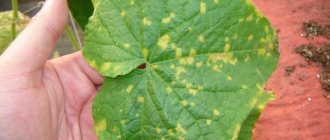We recommend
How to care for cucumbers in a polycarbonate greenhouse
How often should greenhouse cucumbers be watered?
How to care for a polycarbonate greenhouse in the autumn
Cucumbers are a versatile vegetable that everyone loves. The green, crispy, juicy vegetable is suitable for preparing various kinds of salads and cold soups. It grows and develops well in our latitudes. That is why not a single vegetable garden can do without cucumber beds. And it becomes such a pity when the cucumber season begins to wane with the onset of autumn. Is it possible to somehow prolong your pleasure and grow cucumbers even with the arrival of coolness in autumn?
Greenhouse preparation
First you need to prepare the greenhouse itself. This event needs to be given serious attention, since the successful development of plants will depend on this. In the greenhouse that you have been using since the beginning of spring, you need to remove the top 5 cm thick layer of soil. The fact is that over the course of the season, many microbes have accumulated in the top layer of soil, and there are practically no useful substances left. You also need to treat the inside of the greenhouse with a solution of copper sulfate or Bordeaux mixture. Since there are no more plants in the greenhouse, you can prepare a 3% solution. After this, it is necessary to fill the beds with fresh soil at least 5 cm thick.
Organic fertilizer should be added to the soil. It could be manure, humus. They should be evenly distributed over the soil and the beds should be dug up. Rotted manure is applied at the rate of 20 kg per 1 sq. meter.
You also need to install heating devices and water containers in the greenhouse to increase humidity if autumn is dry.
Since the daylight hours in autumn are not as long as in summer, lighting fixtures must also be installed in the greenhouse. In addition, you should check the condition of the trellises.
conclusions
Harvesting a cucumber harvest is far from the end of a gardener’s worries. Autumn preparation of the soil with your own hands and greenhouses for the subsequent planting of cucumbers (and this is a demanding crop, you will have to prepare and do a lot of things) will not only provide the right conditions for growing them, but will also free you up a couple of days in the spring. Seedlings and seeds can be sown in pre-formed beds much earlier. Therefore, this will allow you to receive the first fruits at the beginning of summer.
Read this article on how to properly water tomatoes in a greenhouse.
Growing parameters
When growing cucumbers in the fall, inside the greenhouse it is necessary to create a microclimate suitable for good plant development. Cucumbers develop well at temperatures of 20-25 °C during the day and at least 15 °C at night. In any case, the difference in differences between day and night temperatures should not exceed 7 °C. Otherwise, the cucumbers will get sick, and their yield will be significantly reduced. The air temperature in the greenhouse should not fall below +10 °C. Otherwise, the cucumbers will turn yellow and die.
You shouldn’t heat the greenhouse too much. The air temperature should not rise above 35 °C. Otherwise, the cucumber pollen will become sterile, and the ovaries that have already appeared will stop developing, dry out and fall off.
The air humidity in the greenhouse when growing cucumbers should be 80%. Daylight hours with the help of lighting devices should be extended to summer levels. The lighting fixtures themselves should be placed at a distance of 30-50 cm from the tops of the plants. As the cucumbers grow and the vines rise along the trellis, the lighting fixtures need to be raised higher.
How to extend fruiting of cucumbers until the end of September
Rejuvenate the lashes, pinch the top of the head, make sure they don’t get sick with phytosporin, treat them for prevention and feed them, I have cucumbers that respond very well to granulated chicken manure
Remove all yellow leaves, clean the fruiting vines, feed the vines
In addition to the above, cover it at night, or you can cover it constantly with agrotex. If it's a hot day, ventilate it.
Cucumber care
Caring for cucumbers in a greenhouse in the fall is carried out using approximately the same technology as in the summer in the garden beds. Cucumbers are planted at a distance of 30-35 cm from each other. The seeds are buried in the soil to a depth of 2 cm.
“We are still friends”: Derevianko commented on the breakup with his wife
"Dad is offended." Agata Muceniece about her relationship with Priluchny after the divorce
Smooth and fresh skin: dermaplaning, or why a woman needs to shave her face
For the first time, cucumbers in a greenhouse are fertilized a month after planting and repeated every 10 days. Urea, ammonium nitrate, ammophos or potassium-phosphorus fertilizers are suitable for the greenhouse.
Water the cucumbers in the greenhouse every other day in the fall. After each watering, the soil is loosened, while removing weeds. Watering is done by sprinkling, so that a strong stream of water does not destroy the top layer of soil and damage the roots.
Bushes about 30 cm high are tied up. Scourges 2 m high are pinched. The top and lower side shoots (if any) of plants are cut off with pruning shears.
Cucumbers in a greenhouse in the fall, of course, can get sick. In this case, they are treated using standard technology. Pests are controlled using insecticides, and diseases caused by microorganisms are controlled using fungicides.
Prevention of diseases and pests
The most common cultural diseases include:
- Downy mildew. The disease manifests itself as green and yellow oily spots on the surface of the leaves, which subsequently turn brown. Having discovered this, it is necessary to stop watering and fertilizing, treat the plants with a solution of copper oxychloride or Polycarbacin. After the procedure, you need to ventilate the greenhouse and prevent temperatures below +20°C during the day and +18°C at night.
- Powdery mildew. The green part becomes covered with a coating, becomes yellow-green, dries and curls. For treatment, the bushes are sprayed with a solution of potassium permanganate or mullein.
The plant is often attacked by pests:
- wireworms;
- mites;
- aphid.
Did you know? 1 kg of cucumbers contains only 150 kcal, which makes it an indispensable food product for those who want to lose weight.
To combat this problem use:
- "Confidor";
- "Decis-doublet";
- "Fury" 10%;
- "Zolon" 35%;
- "BI-58".
To reduce the likelihood of disease development and pest damage, it is necessary to clean greenhouses in a timely manner, maintain the distance between plantings and take into account the compatibility of crops before and during planting. Plant fall cucumbers in greenhouses starting in September, follow all the above recommendations and enjoy fresh vegetables all year round.
Additional insulation measures
In autumn there are sharp night and day cold snaps. In this case, the heating equipment in the greenhouse may not cope with its task. To be extra safe, you can set up warm beds for cucumbers in the greenhouse in the fall. To do this, you can use unrotted manure or fresh food waste.
In this case, a trench 40 cm deep is dug in the greenhouse. A 10 cm thick layer of fresh manure is placed on its bottom. A 30 cm layer of fertilized ordinary soil is poured on top.
A Brazilian travels 36 km by bike every day to take his loved one home.
Rare shot: Viktoria Isakova showed her grown-up daughter from Yuri Moroz (new photo)
If there is little snow, there will be no harvest: December 16 is Ivan the Silent Day
You can also simply plant the cucumbers in a regular garden bed and mulch them with a thick layer of well-rotted manure or compost. If the cucumbers in the greenhouse still freeze in the fall, you can revive and support them with the help of the drug “Epin”. You can also spray with a solution of boric acid (5 g per 10 liters of water). If a significant drop in temperature is expected at night, the plants in the greenhouse can be additionally covered with agrofibre or film.
Use of seeds
Cucumbers are stored for the winter not as fruits, but as seeds. Cucumbers grown from their own seeds are more tasty and aromatic. You just need to not be lazy to collect them.
The cucumber seeds are medium-sized. There are about 50 of them in one gram. They have an elliptical shape, elongated, with a pointed end, up to 10 mm long, light cream color.
Store seeds in paper bags or canvas bags in a dry and cool place. Shelf life is up to five years. Although they will sprout in the 20th year of storage, but not in large numbers. The best harvest is obtained from seeds of the third or fourth year of storage.
Such seeds give 95% and 72% germination rates, respectively. The seeds of the first year also germinate well, but give a small harvest, since they bloom with male flowers without an ovary.
The main reason for loss of germination is considered to be high humidity, which leads to rotting. High temperature also reduces germination. Therefore, seeds must be stored in moisture-proof packaging. Thick paper bags that are easy to label and put in a plastic bag are best suited for this. Some well-dried seeds can be conveniently stored in glass jars.
Under optimal storage conditions, seeds can be stored without compromising quality for another 3-5 years.
Sowing rate of cucumber seeds per 10 sq. m is equal to 6-8 grams. 100 plants are planted in this area. When preparing seedlings, add 30% to this number for reserve.
To improve the properties of seeds, in the spring they make special preparations before sowing:
- To protect against viral infections, the seeds are kept for three days at a temperature of +50 °C, and then for another day at +75 °C.
- To protect against bacteria and fungal infections, they are soaked for 3-6 hours in pesticides: Baktofit, Upton.
- To speed up growth, seeds are soaked for 12 hours in a solution of microelements: boric acid, copper sulfate.
After these procedures, the seeds are washed and dried before sowing.
Which varieties are suitable for growing?
The following varieties of cucumbers can be grown in a greenhouse in the fall:
- "Amur". A productive variety that is resistant to temperature changes.
- "Suomi". Cold-resistant, disease-resistant variety with fruits without bitterness.
- "Valaam". Early ripening powerful variety.
- "Sarovsky". A high-yielding variety that produces up to 20 kg of cucumbers per 1 sq. meters.
- "Orpheus". Cucumbers of this variety begin to bear fruit 40 days after emergence.
Found a violation? Report content
Harvesting
The frequency of harvesting may influence the appearance of new ovaries. If the fruits are left untouched for a long time, they will not stop growing and thereby take away strength from the bush. The plant will spend all the useful elements on several large fruits, while the new ones will not get anything at all.
Harvesting occurs when the fruits reach 12-16 centimeters. You should pick them carefully. If tools are used, they are carefully processed. At a certain time there will come a moment of strong fruiting. It is important not to let it run and to collect all the greens on time.
Therefore, the greens are collected when they reach a size of 10-15 cm. They are picked carefully, holding the whip with one hand so as not to damage them.
During the period when plants begin to bear fruit en masse, cucumbers are harvested once every 1-2 days, depending on the area of the greenhouse.
Ripe fruits should be removed on time.
The agricultural technology for obtaining an early harvest in an unheated greenhouse is quite simple and is not much different from seasonal cultivation. If you study all the features in detail, you can still enjoy fresh cucumbers from your own garden at the beginning of May.


